| Hale-Bopp: Hydrogen Cyanide |
|---|
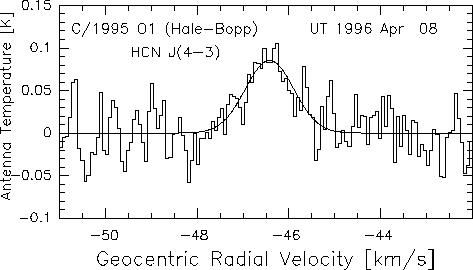
|
DISCOVERY of HCN in HALE-BOPP
The brightest optical emission line in the cometary spectrum is usually that of CN at 3887 A wavelength. CN is a highly chemically reactive radical, and could not exist by itself in the solid material of the cometary nucleus. It has long been recognized that CN must be the "daughter" of a "parent" molecule that has been dissociated (presumably by solar UV). The identity of this parent is unknown, but hydrogen cyanide (HCN) is plausible. The parental identity crisis has been particularly acute in distant (low temperature) comets, where legitimate doubt exists that HCN could itself be ejected from the nucleus. This first observation of HCN in a distant comet (heliocentric distance 4.7 AU) shows directly that HCN is present in the coma, and in quantities sufficient to account for the CN.
|
|
From IAU Circular No. 6377 (April 10 1996)
We observed C/Hale-Bopp (1995 O1) using the 15-m James Clerk Maxwell Telescope on Apr. 08 UT. The 354-GHz J = 4-3 transition of hydrogen cyanide was detected with peak antenna temperature 0.09 K, area 0.11+/-0.01 K km/s, and central velocity -46.4+/-0.1 km/s. At an adopted coma temperature of 10 K (15K), the HCN production rate is Q(HCN) = 5(2)x10**26 per second. This is to be compared with the production rate Q(CN) = 1.1x10**26 per second estimated from optical data (IAUC 6361) on Mar. 19. Within the uncertainties due to modelling the production rates and to the time difference between the measurements, we conclude that HCN is a plausible parent of CN even at the 4.7 AU heliocentric distance of 1995 O1. The spectrum may be viewed at http://www.ifa.hawaii.edu/~jewitt/submm.html. D. Jewitt and M. Senay (Univ. Hawaii) and H. Matthews(Joint Astronomy Centre, Hilo and Herzberg Institute of Astrophysics, Ottawa). |
|
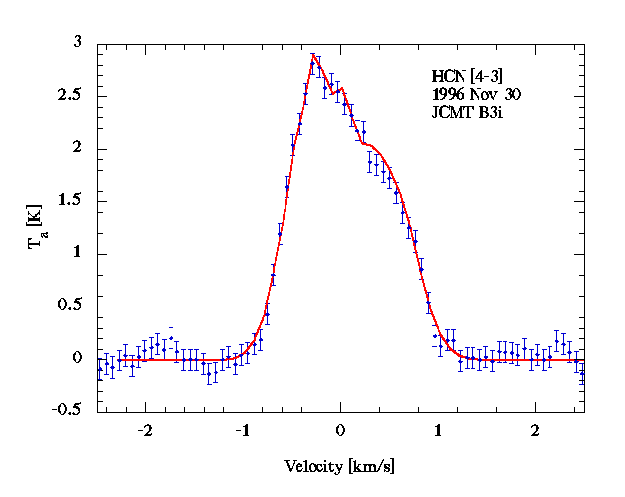
|
GROWTH of the HCN LINE
By the end of 1996, the HCN [4-3] line had brightened by a factor of 30, to peak temperature 3 K. At this time, Hale-Bopp was at 2 AU from the sun. A sample spectrum is shown below:
|
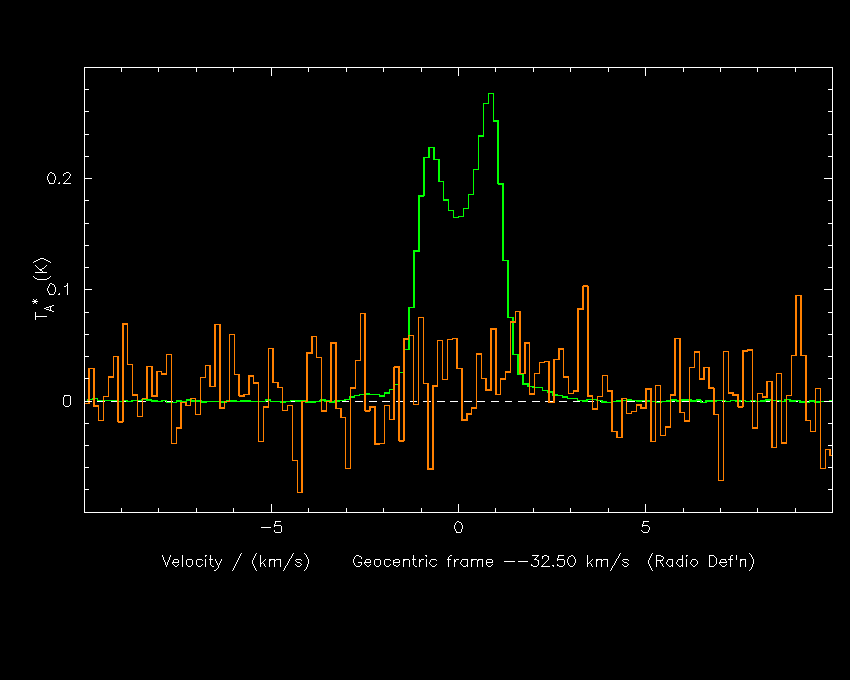
|
DEUTERATED HYDROGEN CYANIDE
A search for deuterated hydrogen cyanide (DCN) was conducted on UT 1997 Feb 16, using Receiver B3. The figure shows the resulting spectrum (red) of the DCN(5-4) line at 362.0465GHz. For comparison, the HCN(4-3) line is also shown (green), but scaled down by a factor of 50. The ratio of the line areas is at least 100:1. To first order, this is also the ratio of the HCN/DCN abundances in the inner coma of Hale-Bopp. This measurement suggests that detection of DCN in comet Hale-Bopp will be extremely challenging. |
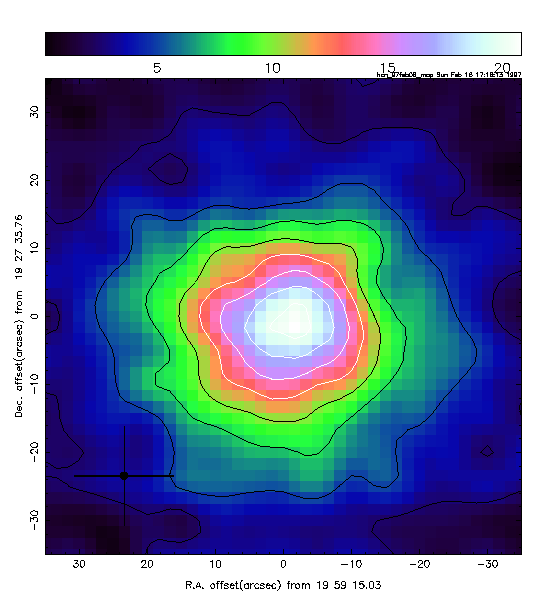
|
FIRST IMAGE OF THE HCN COMA
Map of the HCN(4-3) coma of comet Hale-Bopp obtained UT 1997 Feb 8 at the JCMT. The map was made by raster scanning the 15 arcsec diameter spectrometer beam over the coma. The line strength was integrated over the velocity range -3 km/s to +3 km/s, centered on the instantaneous geocentric velocity of the comet. The resulting map is shown contoured at 2 K km/s intervals, with the highest (innermost) contour at 19 K km/s. The map is color coded for clarity - the colors have no physical significance. At this angular resolution, Hale-Bopp shows none of the jets so prominent in optical wavelength (continuum) data. The width of the map corresponds to about 75,000 km at the comet. |
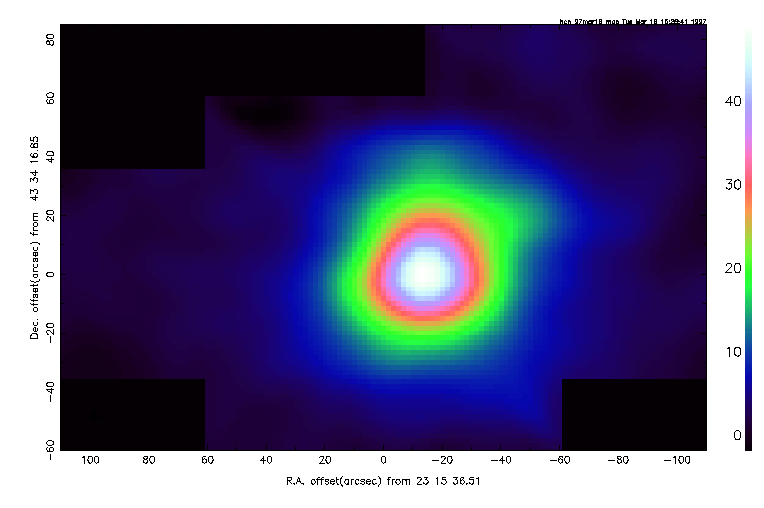
|
MARCH 16 IMAGE OF THE HYDROGEN CYANIDE COMA
Comet Hale Bopp is now too low in the sky for easy visibility from the optical telescopes on Mauna Kea. Instead, this image was obtained at 0.87 mm wavelength using the James Clerk Maxwell Telescope. It shows the distribution of Hydrogen Cyanide (HCN) gas in the inner coma of the comet. The gas streams away from the nucleus at more than 1 km/sec, filling a region more than 100,000 km across. HCN is a "parent molecule". When bombarded by solar ultraviolet photons it breaks apart into the "daughter" species CN and H. CN has one of the brightest emission lines in the optical spectra of comets. HCN has the brightest submillimeter lines. Henry Matthews (NRC, Canada and JAC, Hilo) Matt Senay (FCRAO) and David Jewitt (UH) |
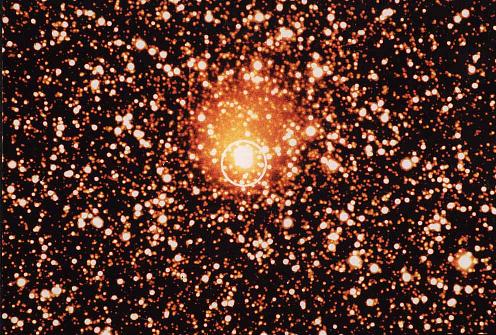
| ||
| Hale-Bopp | Submillimeter | Jewitt |
|---|
Last Updated March 24, 1997